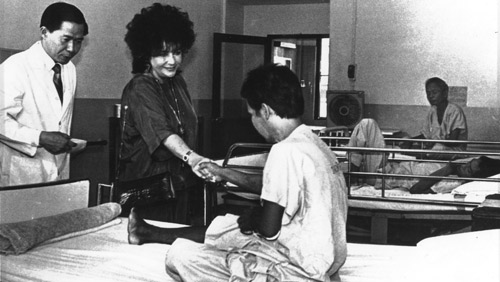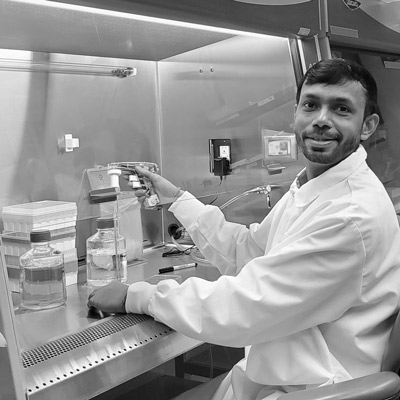A Brief History of amfAR
A Brief History of amfAR
For nearly four decades, amfAR has been accelerating the pace of AIDS research and has contributed to numerous breakthroughs that are extending and saving lives around the world. Since 1985, amfAR has invested nearly $635 million in its programs and has awarded more than 3,800 grants to research teams worldwide. Informed by thorough research and analysis, amfAR is also a highly respected advocate of compassionate AIDS-related public policy. Today amfAR is a leader in the search for a cure for HIV and is one of the largest funders of cure research worldwide.

Sounding the alarm
The first reports of a mysterious new disease affecting young gay men emerged in the summer of 1981. They were brought to the attention of a researcher at New York’s Memorial Sloan-Kettering Cancer Center by the name of Dr. Mathilde Krim by a physician friend of hers, Dr. Joseph Sonnabend. Alarmed at the rapid rise in the number of cases of the new disease, they formed an informal study group to try and determine what was causing the severe and apparently unrelated symptoms these early patients exhibited. By the end of the year, 159 cases had been reported in the U.S.
In 1982 the CDC labeled the disease, acquired immune deficiency syndrome—AIDS. By the end of that year, 771 cases had been reported and 618 deaths—a staggering mortality rate.
In April 1983, Drs. Krim and Sonnabend, along with Michael Callen and a few others in New York City, founded the AIDS Medical Foundation (AMF), the first private organization in the world dedicated to raising funds to support scientific and medical research on AIDS. Its first research grants were awarded in 1984.
Birth of amfAR
In September 1985, the American Foundation for AIDS Research (amfAR) was formed through the unification of AMF with the like-minded National AIDS Research Foundation, which had been incorporated in California in August 1985. Dr. Krim and Dr. Michael Gottlieb (a co-author of the CDC report on the first cases of AIDS in June 1981) became its Founding Chairmen, and Elizabeth Taylor, its Founding National Chairman. One of its first donations was a gift of $250,000 from Rock Hudson shortly before he succumbed to AIDS in October 1985.

amfAR hit the ground running. In 1986, it awarded $1.5 million in research grants. It published its first directory of experimental treatments. And Dr. Krim and Elizabeth Taylor went to Capitol Hill to implore Congress to invest in research and to accelerate access to experimental drugs. The response was sluggish; President Reagan didn’t publicly address the subject of AIDS until 1987—at an amfAR event in Washington, DC.
After establishing the nation’s first two community-based clinical trial units in New York City and San Francisco in 1988, amfAR established a nationwide community-based clinical trials network the following year with grants to 16 sites across the country. The network showed that involving the HIV-positive community in clinical research expanded research capacity and expedited the drug approval process.

Leading on legislation
Also in 1988, amfAR’s Terry Beirn was a primary architect of the first comprehensive AIDS legislation—the Hope Act. amfAR would also be instrumental in securing the passage of major pieces of AIDS-related legislation such as the Ryan White CARE Act and the Americans With Disabilities Act in 1990, and the NIH Revitalization Act of 1993, which strengthened NIH’s Office of AIDS Research.
In 1990, in memory of his brother Sheldon, Arlen Andelson and his wife Michele made a generous donation to establish the Sheldon W. Andelson Public Policy program in amfAR’s Washington, DC, office. Sheldon was a founding director of amfAR who served on the Board until his death from AIDS-related causes in 1987. Arlen joined the amfAR Board in 1993 and served with devotion until his death in October 2019.
Growth and expansion
With little attention being paid to the growing epidemic in Asia, amfAR launched TREAT Asia in 2001 to ensure the safe and effective delivery of HIV treatments throughout the region. TREAT Asia quickly became a model of regional cooperation on HIV/AIDS and today encompasses 21 adult and 20 pediatric sites throughout the region. In its 20 years of operation, the network has helped improve treatment and care in a region that is home to six million people living with HIV.
To reflect the increasingly international scope of its programs, in 2005 amfAR dropped “American” from its name to become simply amfAR, The Foundation for AIDS Research.
In honor of its founding chairman, in 2008 amfAR launched the Mathilde Krim Fellowships in Basic Biomedical Research. The Fellowships continue to be awarded annually to support bright young scientists seeking innovative solutions to the prevention and treatment of HIV/AIDS
Search for a cure
The first case of an HIV cure—“the Berlin patient,” reported in 2008—showed that a cure was possible and was the catalyst for the amfAR Research Consortium on HIV Eradication, or ARCHE, launched in 2010. While many in the scientific community argued that a cure for HIV was impossible, amfAR went out on a limb with an all-out effort to achieve a cure. In 2014, we launched the Countdown to a Cure for AIDS—the biggest expansion of grant making in amfAR’s history.

The cornerstone of the Countdown is the amfAR Institute for HIV Cure Research, established in 2016 with a $20 million grant to the University of California, San Francisco. Today the Institute is undertaking a complex cure-focused clinical trial. The Countdown also led to the formation—by amfAR and with amfAR funding—of a European research consortium called IciStem. Among the cohort of stem cell transplant patients with cancer and HIV followed by IciStem researchers, the London patient (Adam Castillejo) was reported to be cured of HIV in 2019. Patients in Düsseldorf, Germany, New York and California also appear to be free of HIV following a similar stem cell transplant procedure involving cells from donors with a genetic mutation making them resistant to HIV infection.
Today, amfAR is supporting a range of cure-focused strategies. A new grant initiative called ARCHE-GT, for example, is supporting teams of researchers investigating gene therapy approaches to a cure. Importantly, the researchers are charged with developing an intervention that could be delivered by injection, increasing the chances that, if effective, it could be administered without requiring complex laboratory procedures.
COVID-19
In April 2020, amfAR established the amfAR Fund to Fight COVID-19 to respond to the coronavirus via research. Among the grantees, a team of researchers at the University of Montreal were able to identify a protein that appears to have a protective effect against COVID-19. The study generated four scientific papers, including one in the high-impact journal Nature Medicine.
A series of studies led by amfAR’s Public Policy Office were among the first to quantify disparities in impacts of the coronavirus pandemic. A study showing that predominantly Black counties in the U.S. had disproportionately high rates of COVID infections and deaths generated national media attention and was cited in more than 100 publications including the New England Journal of Medicine and JAMA. Subsequent studies pointed to factors that put Latino communities at high risk of COVID-19 and white counties at lower risk of both COVID-19 and HIV.

Galvanizing the scientific community
Since 1985, amfAR has awarded more than 3,300 grants to research teams worldwide and has invested more than $635 million in its programs. amfAR’s research investments have contributed to the development of antiretroviral drugs that are keeping millions of people alive, and helped eliminate mother-to-child transmission of HIV in many parts of the world. And amfAR has galvanized a scientific community that, once deeply skeptical, has largely embraced the notion that a cure is not only possible but achievable in our lifetime.
For their courageous leadership on HIV/AIDS, in 2000 Dr. Krim received the Presidential Medal of Freedom, the nation’s highest civilian honor, and Elizabeth Taylor was made a Dame of the British Empire. Dame Elizabeth passed away in 2011 and Dr. Krim, in 2018. Of Dr. Krim, legendary playwright and AIDS activist Larry Kramer wrote, “…one can only be filled with overpowering awe and gratitude that such a person has lived among us.”